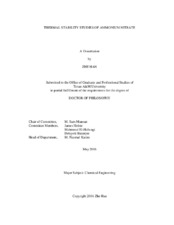| dc.description.abstract | Ammonium nitrate (AN) is widely used in the fertilizer industry and is one of the most concentrated forms of nitrogen fertilizer. However, AN is associated with various hazards including fire and explosion, which have occurred continuously in the past. AN is not considered a flammable or combustible material at ambient temperature and pressure; however, it is a strong oxidizing agent that can detonate under certain conditions.
The primary goals of this work are to advance the understanding of the root causes associated with AN explosions and find out ways to make AN storage inherently safer by studying its thermal stability. This research focuses on condition-dependent AN decomposition, including the effect of additives, confinement, heating rate, temperature, thermal history, and sample size. Pseudo-adiabatic and adiabatic calorimeters are used to study the characteristics of AN decomposition. Thermodynamic and kinetic parameters are evaluated; models are proposed to predict the temperature rise of AN mixtures with additives; decomposition pathways are analyzed; safer AN storage conditions are identified; and AN explosion phenomenology are reported. In addition, this work discusses the role of water as a chemical, interfering physically and chemically with AN-related fire scenarios possibly leading to explosions.
Thermal stability analysis showed that AN is stable up to approximately 200 °C. Sodium sulfate is a good inhibitor for AN in that its presence can mitigate AN decomposition, while potassium chloride is a promoter because it intensifies the runaway reaction. AN should be separately stored from promoters, even when inhibitors are also present. Furthermore, exposure of AN to heat and storage in confined spaces should be avoided, and the size of AN piles should be limited. While water remains the choice for tackling AN-related fires, care should be taken in doing so. It must be understood that a significantly sufficient quantity of water should be used. Actually, evidence shows that insufficient quantities of water may exacerbate the fires and consequences.
This work demonstrates the complexity and the multiple studies required for making AN safer as a fertilizer, providing suggestions to the fertilizer industry. It can also serve as a model for studies on various reactive chemicals. | en |


